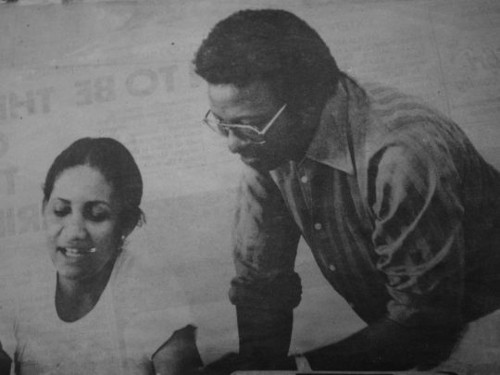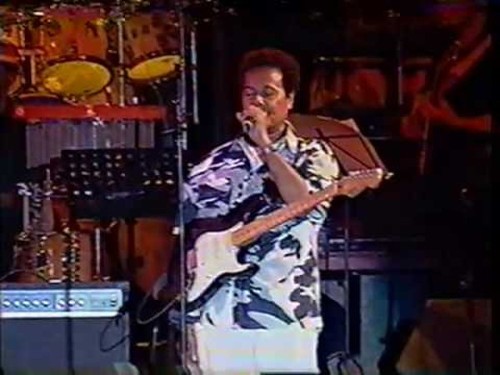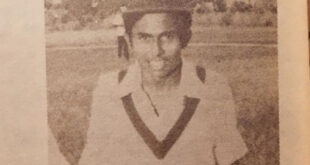Bim Singh’s final fall is the harsh culmination of the metaphor of entrapment that runs through the film. A mesh, inescapable, awaits Bim everywhere, even in his opulent, new haven. It is an element of the past which refuses to go away that jumps out of nowhere on his return from a reception at Governor’s House and seals his fate.

Taking advantage of his absence, his childhood sweetheart sneaks out of their St Clair mansion for a breath of fresh air. During her innocent, lung-filling walk around the Queen’s Park Savannah, she is accosted by someone who remembers her as “the sweetest piece of arse in Port-of-Spain.” Happenstance witness to this, Bim does not hesitate. He leaps out of his chauffeur-driven vehicle and, just outside the main entrance to the southernmost of the Magnificent Seven, my old school, he gives the accoster his come-uppance.
The film ends with a close-up of Bim as he realises what he has done. Maraj’s face is frozen in golden black. Black, the colour of horror par excellence which contains every hue, is pitted against gold. Robertson is careful to establish the pre-eminence of black/horror over the more positive symbolic charge of the less murky pallor of the background. The screen is filled by sinister black, set against gold, scarred with tonalities of white, Bim’s teeth, bared like fang, taking on a thick, gruesome dimension within the frame. Overriding black. Fangs of white. Background gold. The juxtaposition is arresting, this golden black final frame a magisterial parting shot.
Before we get to such foaming cinematic depiction of horror, we are treated, throughout the rest of the piece, to the full range of colour schemes that lead up to that explosion. The gold and glitter of the countryside, with soothing, gentle landscapes that are constantly punctuated with elements of gloom. Airs of pleasantness unceasingly tinged with intrusive overtones of a darker, more sinister hue. Characters escaping back to rural settings initially enveloped in bright, almost impressionistic countryside colours and soon encountering tales of misfortune and evil deeds done to loved ones. It is never long before, even within such an environment, they are enshrouded in sombre tinctures.

Beyond the personal dilemmas of individual characters, the same is true of the manner in which the entire body of the film is mapped out across 100 minutes. Colours that initially provide a glow of freeness and openness in seaside milieus are tainted by squads of police making raids to ferret out illegal immigrants being smuggled in late at night; the camera, meanwhile, engages with subjects either from a position of height and insurmountable authority or surges upwards from beneath, like a hostile force of Nature or a dangerous animal that springs out of nowhere to strike down hapless victims. The bright countryside is discoloured by sinister, night-light dinners at which boat captains discuss the least messy way to rid themselves of two-timing policemen. There is ongoing interplay between full, free-flowing frames, offering possibilities for self-definition, and tighter, more stymieing frames, imbued with ominous tinctures.
The challenges presented by the film’s dense midriff are particularly well met. More than merely dense, the overly demanding film grammarian might argue, that midriff is overloaded. (S)he has a case. It encompasses all of the more than 60 minutes between Bim’s arrival in Port-of-Spain over Jumbie Call and the beginning of the final block, by which time he is an established political leader about to descend into unmitigated horror.
But the overwhelming weight and intensity of the film’s charged midriff does not prevent Robertson et al from calmly quickening the pace during it. There is deft alternating between full, free-flowing and tighter, increasingly stringent framing. Throughout, we can almost see Robertson’s directorial hand keeping the different blocks separate, we are not unaware of Sparks’ playful control of colour and we imagine Evans meticulously overseeing the stitching together of the filmed footage. Their combined efforts yield 100 minutes of compact, balanced, eye-catching, potent frame-by-frame discourse.

Sitting comfortably astride all of that is Tanker’s music. Atop all the intricate interplay between the purely formal aspects of film grammar, Tanker intones all the dilemmas and conflicts thrown into sharp relief by the use of more strictly grammatical tools. His score is an ode to the raw creative possibilities to be found in the underbelly of Bim’s universe. All the close encounters, anger, sparring, hostility and crime are constantly over-layered by the wondrous musicality that such a universe also engenders.
Tanker proposes vibrant metaphors of music, melodies of anger, dismay, joy and disenchantment. Every musical piece responds to the constant confrontation between all of the above. My favourite remains “Jumbie Call,” which accompanies the troubled, anxious face of the adolescent Bim making his way to town against the backdrop of the green, liberating countryside. That contrast foreshadows the asphyxiating world he is about to enter.
Tanker knows how to make creative space harmoniously co-exist with hostile space and how to make restless, troubled characters find relief from the turbulent events and situations of conflict in which they find themselves. There might be no escape but there is the ever-present possibility of assuagement. The music plays its part in depicting the necessarily limited aspirations of those trapped in this universe. Alongside all the punching, counter-punching and open warring, there is also much exaltation of the honest quest for bonding and interaction. What Bim Singh is constantly trying to achieve but cannot is incessantly pitted against what Tanker shows as being achievable via more creative avenues.

As a musical feat, Bim was perhaps the first audible round of a debate that is still raging today. Echoes of what are now the very diverse and well established forms of musical creativity and production of Trinidad and Tobago were first heard back then in Tanker’s work, in the music he created for Bim and in much of his work prior to the film’s score (“The River Come Down,” “Forward Home,” “Living for Lena”). In Bim, every note is a metaphor, every beat a character, every sound coming from a drum, pan or sitar a little musical piece in sync with the steps being taken by some one of the film’s characters.
For Tanker, it is an elaboration of exquisite release. His artistry was not the product of rigid schooling. Just as no one taught Derek Walcott to write metaphors that speak so powerfully of the Caribbean, his music is like Walcott’s poetry in the way the latter drew on and fed off the region’s landscape for poetic undertaking. Tanker’s remarkable vision is simply the vision of a remarkable creator. And fortunately for us all, that creator was commissioned to take charge of the music for T&T’s first significant home-grown feature film.
Four and a half decades later, as we revisit Bim and savour its score, Walcott’s imagery and metaphors inevitably creep into our retina and our mind’s eye as we grapple with the perennial socio-anthropological issues of Caribbean civilisation. It is easy to see in the body of lived reality informing the story conceived by Pantin and the Robertsons, set in the late 40’s and early 50’s, the race, politics and culture clashes and violence of today.
Not only does today’s audience better appreciate Bim for what it continues to be, we can also continue to understand, condemn or empathise with the film’s main character. This refers both to the celluloid one our eyes see on the screen and the one our ears translate into feelings for us because the flesh and blood Bim is really inseparable from Bim, the musical entity.

For that, we have to say a heartfelt thanks to Andre Michael Tanker, who was to Caribbean music, I submit, what Walcott was to Caribbean literature.
Editor’s note: The author of this piece is Owen Thompson, a Trinidadian who has lived and worked in Spain, France and England since the early 1980’s.
Click here to read Part 1 and here to read Part 2.
 Wired868 Wired868 for smart sport news and opinion
Wired868 Wired868 for smart sport news and opinion






